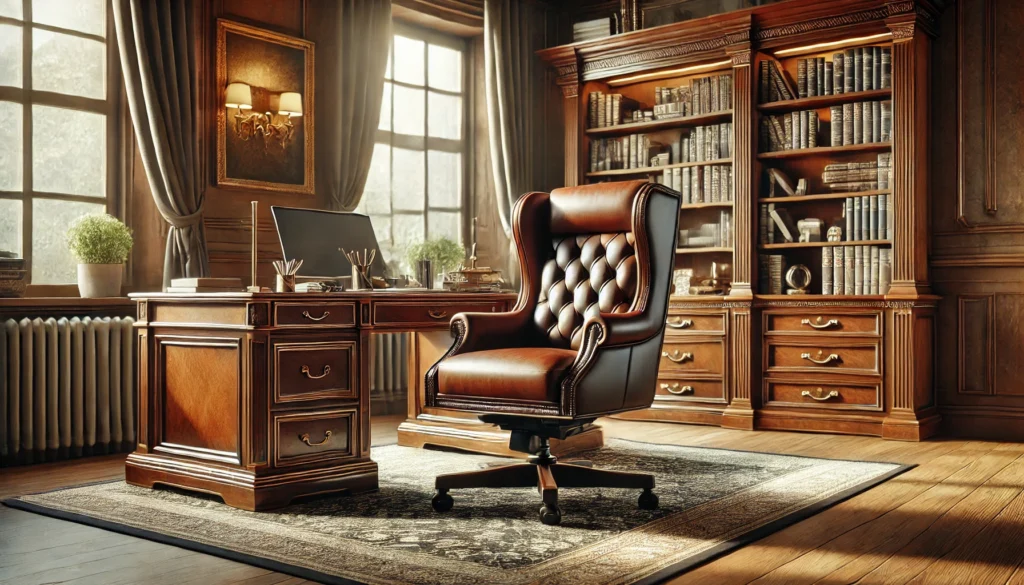Introduction
Choosing the right Leather Office Chair is a crucial decision for anyone who spends a significant part of their day seated at a desk. The ideal chair not only provides comfort but also enhances the workspace’s aesthetic appeal and supports your long-term health and productivity. Among the many materials available, leather stands out as a symbol of luxury and sophistication in office furniture. In this article, we delve into the world of leather office chair, guiding you through the benefits, varieties, and maintenance tips to help you make an informed choice. Whether you’re outfitting a new office or upgrading your current chair, understanding the unique qualities of leather will ensure you find the perfect blend of style, comfort, and durability.
The Allure of Leather in Office Furniture
Leather Office Chair has been a preferred material for furniture since ancient times, appreciated for its durability, comfort, and aesthetic appeal. In the modern office, leather chairs are prized for their ability to elevate the look of a workspace with their classic, yet contemporary, elegance. Leather is unique in its ability to improve with age, often developing a rich patina that adds character to the furniture. Its popularity in office settings also stems from its durability and the comfort it offers. Leather adapts to the surrounding temperature, staying cool in the summer and warm in the winter, providing year-round comfort.
Additionally, Leather Office Chair natural properties include its resistance to spills and dirt, making it an ideal choice for environments where cleanliness and maintenance are priorities. Its robust nature means it can withstand the rigors of daily use without suffering from the wear and tear that fabric office chairs might endure. As such, leather chairs not only offer a stylish appearance but are also a practical choice for any office environment.
Types of Leather Used in Office Chairs
When selecting a leather office chair, understanding the different types of leather available and their characteristics can significantly influence your decision. The most common types include:
- Genuine Leather: This is the least expensive and most widely used type in office chairs. It is made from the lower layers of the hide and is treated to give a uniform appearance.
- Top-Grain Leather: A premium choice, top-grain leather is thinner and more workable than full-grain, providing a balance between luxury and durability.
- Full-Grain Leather: Considered the highest quality leather, it includes the outer layer of the hide, featuring natural grains and offering maximum durability and breathability.
- Bonded Leather: Made from leftover scraps and synthetic materials, bonded leather is an economical alternative that mimics the look and feel of real leather.
Each type of leather has its own set of advantages and disadvantages, from cost to durability to aesthetic appeal. High-quality leather, such as full-grain, is more durable and retains its appearance over time, making it a wise investment for a busy office. Meanwhile, bonded leather might be more suitable for those on a budget or with lighter use in mind.
Choosing the Right Leather Office Chair

Selecting the right leather office chair involves more than just picking a color or style. It’s essential to consider various factors to ensure it meets your needs:
- Budget: Leather chairs range in price, influenced by the type of leather and the chair’s features. Determine your budget beforehand and find a chair that offers the best combination of materials and ergonomics.
- Ergonomic Features: Look for chairs that support spinal health, such as those with adjustable lumbar support, tilt mechanisms, and ergonomic armrests. These features help maintain proper posture and reduce the risk of strain or injury.
- Size and Space Compatibility: Ensure the chair fits well in your workspace. Consider the chair’s dimensions and how it will move around your desk area.
Opting for a chair with adjustable settings allows you to customize the fit and comfort level, enhancing your overall productivity and well-being while working.
Caring for Your Leather Office Chair
Maintaining a leather office chair is key to preserving its quality and extending its lifespan. Regular cleaning and conditioning will keep the leather supple and prevent cracking or peeling. Use a soft cloth and approved leather cleaners to gently wipe down the chair, avoiding harsh chemicals that can damage the material. For deeper cleans, consider using a professional leather cleaning service once a year.
Additionally, keep your leather chair away from direct sunlight and heat sources to prevent fading and drying out. If spills occur, clean them immediately to prevent stains from setting. Regular maintenance not only keeps your chair looking its best but also ensures that it remains a comfortable and healthy choice for your office.
Conclusion
Investing in a leather office chair can transform your workspace, adding a touch of elegance and providing lasting comfort. By understanding the different types of leather, prioritizing ergonomic features, and maintaining the chair properly, you can enjoy the benefits of a leather chair for years to come. Consider your specific needs and the unique characteristics of leather to choose a chair that blends style, functionality, and comfort.
Frequently Asked Questions (FAQs)
What is the best leather for an office chair if I’m on a tight budget?
Bonded leather is a cost-effective option that offers the look and feel of real leather without the high price tag.
How can I tell if a leather chair is high quality?
High-quality leather chairs are generally made from full-grain or top-grain leather, have a natural texture, and are sturdy and well-constructed.
What are the main differences between genuine leather and bonded leather chairs?
Genuine leather is made from real animal hide, while bonded leather consists of leather scraps and synthetic materials pressed together.
Can leather office chairs cause skin allergies?
Real leather is less likely to cause allergies compared to synthetic materials, but it’s always good to check the type of tanning agents used.
How often should I clean and condition my leather office chair?
Cleaning monthly and conditioning every six months is recommended to keep the leather in optimal condition.
You May Also Read: https://usdigitaltime.com/rainfall-shower-head/
